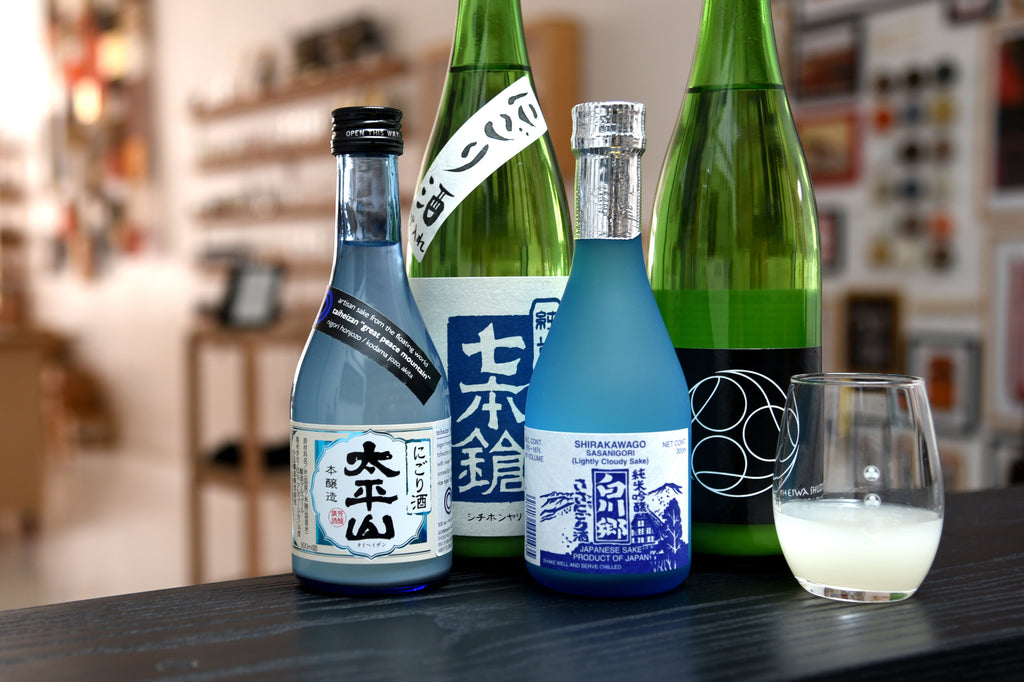 Sake Gumi is our monthly sake subscription service with 200 members throughout California. Join today!
Sake Gumi is our monthly sake subscription service with 200 members throughout California. Join today!
My goal for this month is to show you that there’s more to nigori than sweet, syrupy sake in pink bottles. The bottles this month are all made by small brewers who are trying to do something unique with the genre. You’ll notice that these nigoris aren’t as opaque as many nigoris you see, but they also express complexity in taste - balancing acidity, umami, and sweetness.
As I touched on last month, nigori is sake that has been lightly pressed, meaning that some of the kasu (sake lees) have passed through the mesh during pressing, resulting in a sake that looks cloudy. The kasu is slightly sweet and chunky, so nigoris tend to be sweeter and more viscous than other types of sake.
Back in the day, when people first started making sake, they were likely making nama nigori murokas (unpasteurized, unpressed and uncharcoal-filtered). Most sakes were homemade and people were not in the habit of pasteurizing, pressing, and filtering. These sakes looked similar to what we know as nigori sake today. As sake-making grew up, ambitious brewers started getting into pasteurizing, pressing and filtering - resulting in clear, dry, and shelf-stable sakes. Methods such as pasteurizing, pressing, and filtering not only differentiated brewers' products, but also moved sake-making into a more sophisticated arena of brewing.
So why do people still make nigori? The texture and flavor of nigori still delights sake drinkers. And with the new trend in Japan of lighter and drier nigoris, the range and quality of nigori is becoming vast and interesting. In fact, every time I go back to Japan, I see more and more usunigori sakes (lighter style nigoris, mostly namas) appearing as limited offerings in the basement of department stores and special menus at izakayas - these are definitely not your mom’s nigori.
I am excited to introduce four sakes that are all relatively dry and incredibly savory for nigoris. I want to debunk the assumption that all nigoris are syrupy, sweet, and hard to pair with foods. On the contrary, these multi-faceted nigoris beg to be paired with anything from Cowgirl Creamery’s Red Hawk cheese to a spicy Thai curry. Kanpai! Yoko
Kanpai!
Yoko
Co-Founder + Sake Director
Umami Mart
LEVEL 1: Introductory Membership (Two 300ml bottles)
 Taiheizan Nigori Honjozo
Taiheizan Nigori Honjozo
Kodama Brewing Company (Akita, Japan)
Seimaibuai: Local Akita Table Rice 65%, SMV: +2
Can you believe that I’m using the words “crisp” and “refeshing” to describe a nigori? I could hardly believe it myself. Coming from Kodama Shuzo in Akita (famous for their Akita Kimoto Method), this tart nigori has banana and grass on the nose, then progressing into mouth-watering juicyness, with an assertive, dry and fizzy finish. Notice the pronounced acidity that lends well to pairing with savory foods like Cowgirl Creamery's Hop Along, a rich, semi-firm organic cow's milk cheese. Serve chilled.
 Shirakawago Sasanigori Junmai Ginjo
Shirakawago Sasanigori Junmai Ginjo
Miwa Shuzo (Gifu, Japan)
Seimaibuai: Toyama Gohyakuman-goku 60%, SMV: +1.5
Miwa Brewery holds the Doburoku Festival in Shirakawago every fall. Their nigori lineup includes a doburoku (a thick porridge-like sake), regular nigori, and this sasanigori (light nigori) - so we know they are serious about nigori. Get your nose in the glass to take in the cereal aroma of amazake, fresh steamed rice, and a hint of citrus. There’s a lingering finish here that is comforting - like having a spoonful of porridge. Enjoy this savory sake chilled or with a single ice cube.
LEVEL 2: Premium Membership (Two 720ml bottles)
 Shichi Hon Yari Junmai Ginjo Nigori “Winter Warrior”
Shichi Hon Yari Junmai Ginjo Nigori “Winter Warrior”
Tomita Brewery (Shiga, Japan)
Seimaibuai: Tamazakae 60%, SMV: -4
When I visited Shichi Hon Yari last year, I got to see just how old and small their production is - talk about craft brewing. I feel lucky that they even export their product to the U.S. This nigori is complex - featuring aromas of malt, lychee, and porridge. Just like their junmai, this nigori has a sturdy structure - thanks to both a pronounced acidity, and a rye-like finish. Enjoy chilled with a funky cheese like Red Hawk or a spicy, coconut curry.
 Heiwa Nigori
Heiwa Nigori
Heiwa Shuzo (Wakayama, Japan)
Seimaibuai: Ippanmai 75%, SMV: -8.5
Heiwa’s sakes are like a classical music number. The toji (master brewer) is a maestro at balancing the higher treble tones with lower bass notes. This is a perfect example of an orchestra of tastes - tart yogurt, sweet candy cap mushrooms, earthy peach, and savory malt. Although this lush, rich, and creamy nigori has a sustaining finish, it doesn’t feel like it’s overstaying its welcome as ultimately it ends dry. Enjoy chilled with hot coppa or skewered yakitori vegetables and meat with sansho pepper.



Comments (0)
There are no comments for this article. Be the first one to leave a message!